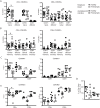Maternal-Fetal rejection reactions are unconstrained in preeclamptic women
- PMID: 29176779
- PMCID: PMC5703473
- DOI: 10.1371/journal.pone.0188250
Maternal-Fetal rejection reactions are unconstrained in preeclamptic women
Abstract
The risk factors for preeclampsia, extremes of maternal age, changing paternity, concomitant maternal autoimmunity, and/or birth intervals greater than 5 years, suggest an underlying immunopathology. We used peripheral blood and lymphocytes from the UteroPlacental Interface (UPI) of 3rd trimester healthy pregnant women in multicolor flow cytometry-and in vitro suppression assays. The major end-point was the characterization of activation markers, and potential effector functions of different CD4-and CD8 subsets as well as T regulatory cells (Treg). We observed a significant shift of peripheral CD4 -and CD8- T cells from naïve to memory phenotype in preeclamptic women compared to healthy pregnant women consistent with long-standing immune activation. While the proportions of the highly suppressive Cytokine and Activated Treg were increased in preeclampsia, Treg tolerance toward fetal antigens was dysfunctional. Thus, our observations indicate a long-standing inflammatory derangement driving immune activation in preeclampsia; in how far the Treg dysfunction is caused by/causes this immune activation in preeclampsia will be the object of future studies.
Conflict of interest statement
Figures



References
-
- Cudihy D, Lee RV. The pathophysiology of pre-eclampsia: current clinical concepts. J Obstet Gynaecol. 2009;29(7):576–82. Epub 2009/09/17. doi: 10.1080/01443610903061751 . - DOI - PubMed
-
- Siddiqui AH, Irani RA, Blackwell SC, Ramin SM, Kellems RE, Xia Y. Angiotensin receptor agonistic autoantibody is highly prevalent in preeclampsia: correlation with disease severity. Hypertension. 2010;55(2):386–93. Epub 2009/12/10. doi: 10.1161/HYPERTENSIONAHA.109.140061 . - DOI - PMC - PubMed
-
- Irani RA, Zhang Y, Blackwell SC, Zhou CC, Ramin SM, Kellems RE, et al. The detrimental role of angiotensin receptor agonistic autoantibodies in intrauterine growth restriction seen in preeclampsia. J Exp Med. 2009;206(12):2809–22. Epub 2009/11/06. doi: 10.1084/jem.20090872 . - DOI - PMC - PubMed
-
- Tal R. The role of hypoxia and hypoxia-inducible factor-1α in preeclampsia pathogenesis. Biology of reproduction. 2012;87(6):134 doi: 10.1095/biolreprod.112.102723 . - DOI - PubMed
-
- Lau SY, Guild SJ, Barrett CJ, Chen Q, McCowan L, Jordan V, et al. Tumor necrosis factor-α, interleukin-6, and interleukin-10 levels are altered in preeclampsia: a systematic review and meta-analysis. American journal of reproductive immunology. 2013;70(5):412–27. doi: 10.1111/aji.12138 . - DOI - PubMed
MeSH terms
Substances
Grants and funding
LinkOut - more resources
Full Text Sources
Other Literature Sources
Research Materials

